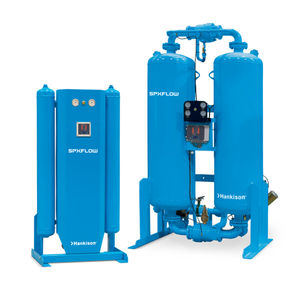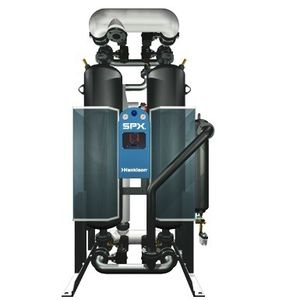
Heatless desiccant compressed air dryer HSHD seriestwo-stagecompactlow-pressure



Add to favorites
Compare this product
Characteristics
- Technology
- heatless desiccant
- Number of stages
- two-stage
- Other characteristics
- compact, low-pressure
- Capacity
Max.: 68 m³/h
(2,401.4 ft³/h)Min.: 12 m³/h
(423.78 ft³/h)
Description
Compact and intuitive, Hankison’s HSHD Series Modular Desiccant Air Dryers feature robust communications, are CSA/UL approved, and CRN registered. As powerful as it is versatile, HSHD was designed and proven in Germany to protect moisture sensitive applications requiring low-pressure dew points by delivering dew points of ISO 8573-1: 2010 Class 1 (-100°F, -70°C) and Class 2 (-40°C) with flow rates of 7 to 40 scfm (12 to 68 nm3/h). HSHD—a perfect solution for labs, hospitals, pharmaceutical manufacturing, and other high-tech installations that demand performance and reliability.
Compressed air enters the dryer and is directed to Tower 1 by valve (A), and then to the dryer outlet through shuttle valve (B). A portion of the dried air is throttled to near atmospheric pressure by means of orifice (C). This extremely dry, low-pressure air flows through and regenerates the desiccant in Tower 2 and is exhausted through purge/repressurization valve (D) and exhaust muffler (E) to atmosphere. After a set time, the automatic solid state timer closes purge/repressurization valve (D) allowing Tower 2 to repressurize slowly. At the end of 2 minutes, valve (A) shifts and purge/ repressurization valve (D) reopens. The main air flow is now dried by Tower 2 while Tower 1 is being regenerated.
Catalogs
No catalogs are available for this product.
See all of HANKISON‘s catalogsRelated Searches
- Compressed air dryer
- Adsorption compressed air dryer
- Refrigerated compressed air dryer
- Compact compressed air dryer
- High-quality compressed air dryer
- Two-stage compressed air dryer
- Single-stage compressed air dryer
- High-pressure compressed air dryer
- Membrane compressed air dryer
- Blower purge compressed air dryer
- Non-cycling compressed air dryer
- Low-pressure compressed air dryer
- High-temperature compressed air dryer
- In-line compressed air dryer
*Prices are pre-tax. They exclude delivery charges and customs duties and do not include additional charges for installation or activation options. Prices are indicative only and may vary by country, with changes to the cost of raw materials and exchange rates.






